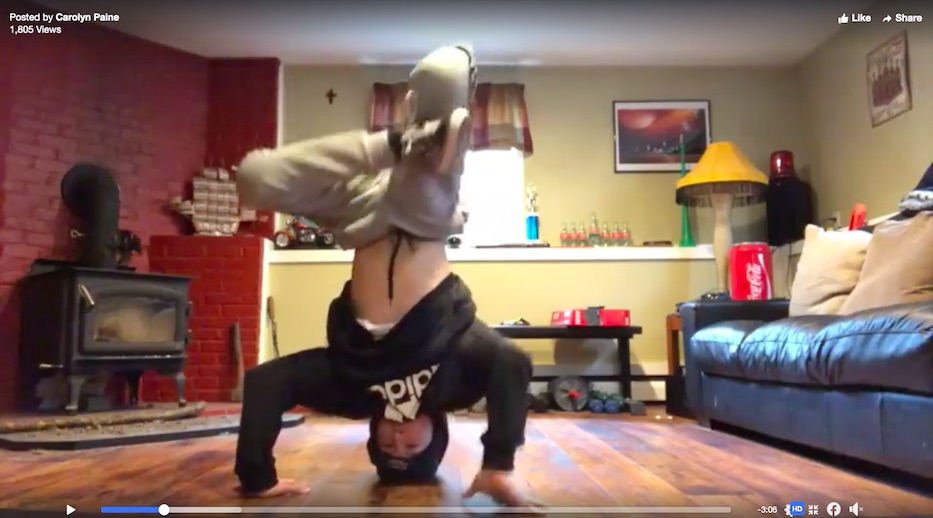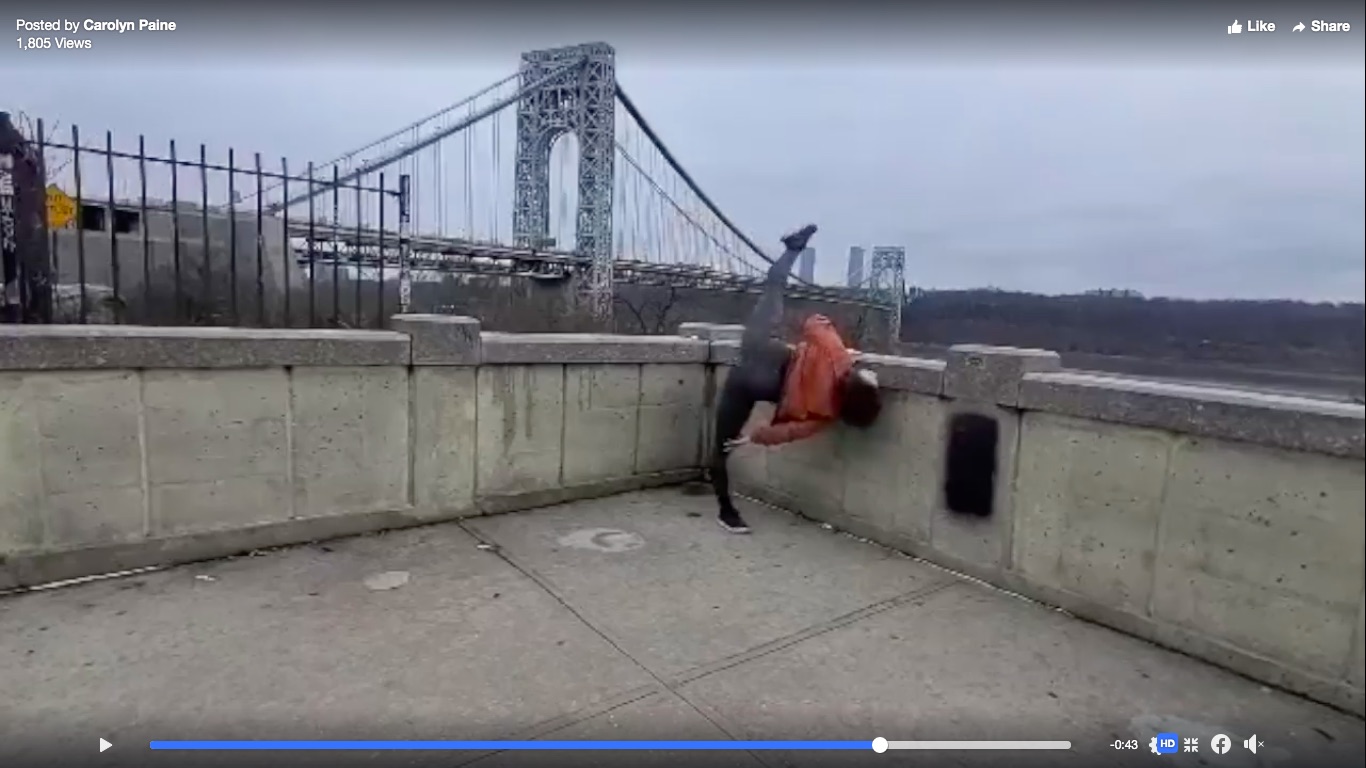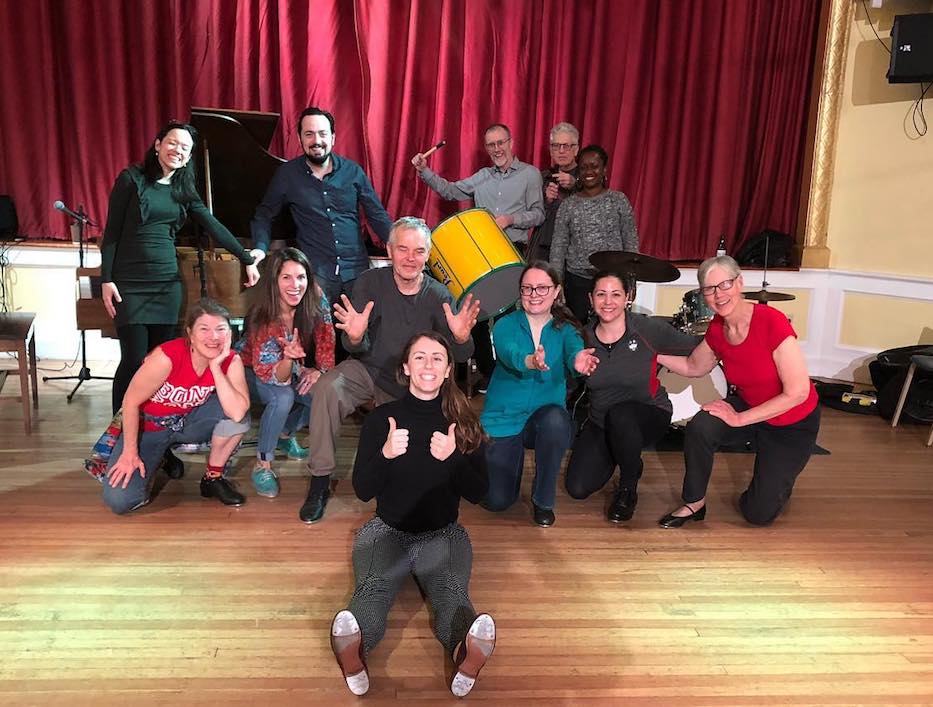
Culture & Community | Dance | Elm City Dance Collective | Hartford | Arts & Culture | COVID-19

| Facebook. |
The video opens on a dancer in her backyard, drenched in sunlight. Her arms lift skyward; her torso is suddenly a wave, rolling forward. The scene shifts: a ballerina is doing stretches at her kitchen counter, leaning in where the cutting board might otherwise be. It shifts again, and a breakdancer is holding a cypher for one in his bedroom. Again, and a tap dancer is all alone in her studio, a mirrored wall stretching out behind her.
The video is the project of Hartford-based dancer, actor and comedian Carolyn Paine, who has also held an impromptu, appropriately distanced Les Mis sing-along from the front porches of her neighborhood. As she and other dancers enter the third week of COVID-19 enforced isolation, several are trying to hold onto their practice as classes move online and performances, festivals, and gigs are cancelled for months.
“I am just trying to keep busy,” Paine said, noting that she and her roommate, dancer Alex Zarlengo, have tried to find ways to break through an increasingly grim news cycle. “For now we are sane, happy, healthy, and just trying to stay in touch with what we love and who we love.”
One of the ways she has done so—in addition to quarantine cocktail hours and dance and yoga interludes from her kitchen—is by letting other dancers know they are not alone. Earlier this month, she put out a call to dancer friends across the globe for videos of them dancing in their personal spaces. She received over three dozen submissions, from hip-hop artists breaking it down in empty garages to young kids Irish dancing through open Connecticut fields.
Some dancers stood by their driveways and in their backyards. Others used their bed frames, dressers, and kitchen countertops in the absence of barre equipment. One knocked over a painting with his extended leg and kept going. He ended the video with a huge grin.
"We may not get to do the show we were in or choreographing, we may not get to go take class or audition, but we keep dancing," she wrote with the video. "The best part for me of putting this together was getting to see all of these people doing what we all love. Together. Enjoy. Share. Keep dancing everyone."
The reality for many of them is filled with intense financial uncertainty. Bonita Weisman, a West Hartford dancer who has built a career as an improvisational dance artist and teacher, has been posting semi-regular outdoor “prayer dances” as classes and activities come to a halt around her.
While she is still teaching weekly classes at the Hartt School online, for which she is paid $80, her other streams of income have dried up. Less than $100 per week isn't going to cut it, she said. While she is able to dip into her retirement savings a little, doing so is not sustainable.
“I have all my bills and no income,” she said. “I’m disoriented and overwhelmed. But I'm also an improviser. That’s my gift as an artist. A lot of what I do is about helping people access their own creative potential … to me, dance is about expressiveness, about heart, about community, about sharing.”
The prayer dances, she added, are part of that work. While Weisman is no stranger to video-recorded performances—she has done several dance improvisations with poetry and audience participation that are accessible online—she said that Facebook Live is a relatively new medium for her.
She has posted the videos to her personal Facebook page with the hope that viewers will be inspired to move themselves.
“If I don't move, I don't do well,” she said, adding that she’s been moving since she was a kid in New York, living close to the 92nd Street YMCA. “That's always been the case for me … this idea of people saying I can't dance, I say bullshit to that. Anyone can dance.”
Marcia Brooks, a dancer who runs MiXt Company out of Greenwich, said that she’s been watching the news as it develops and trying to remain as flexible as she can. As shutdowns were ordered around the state, the company went on pause, where it now remains. In the first week of advised isolation, she started leading weather-reliant “Beautiful Day Dances” in a neighborhood park, where attendees stood at least six feet apart from each other.
Now that social gatherings have been cut significantly—capacity has gone from 50 to 5 in under 14 days—it’s unclear whether the dances will continue. She said she remains hopeful that dancers of all levels—and neighborhood residents who just need to take care of their physical health—can continue the dances in their yards, driveways, and homes. She added that she’s been buoyed by watching check-ins develop with the online dance community.
“I feel like the Facebook connection is really strong, and we don't always get to share with each other,” she said. “It's exciting to be part of that and contribute, and to consider how we respect and share dance at this time.”
Elisabeth Jeffrey, a colleague of Paine’s who is based out of New York City, watched as all of her dance performances, company gigs, and her restaurant job disappeared overnight earlier this month. She recalled sitting on her bed the Monday that shutdowns were announced and enforced across the city, and counting email cancellations that came in one after another.
“It’s a very new experience,” she said. “I've never stayed home for more than two days in a row. Now I don't know if the companies that I dance for will open again,” she said. “The restaurant that I work for let us go after 10 years. Financially, it's bad. Part of me, with this online community, thinks it’s great. It’s broadening the space. But part of me is like: we’re all donating $5 to the same people. Who is that going to help?”

| A screenshot from Paine's video. Facebook. |
She added that she’s been chipping in where she can, including in Zoom ballet and barre classes that help her maintain a daily practice. But she also doesn’t know how long her finances will hold. It’s the first time she’s been without reliable work—and without health insurance, which she was receiving through a dance company—in years.
Even with temporary unemployment benefits, which took four days of hourly phone calls before Jeffrey got through to a human being, she and her partner can’t afford the public option for health insurance. Going home to her native Minnesota isn't an option either, because her parents are severely immunocompromised.
She called the situation almost laughable: she's deprived of health insurance when she may need it most, and she's a mover with almost no space to move.
But she is also dancing through it, and trying to savor the enforced slowdown as much as she can. While she has almost no room to dance at home, she said she’s making the most of it. She has spent more time connecting with dancers online than she can remember ever doing. She has taken the time to cook and savor a cup of coffee.
“I don't know how long it's gonna last or gonna be,” she said. “I think most of us have been communicating with our dance community more than normal.”
Elsewhere in the tristate area, several professionals are finding new ways to move—and help others move—through isolation. Barry Kerollis, a dance educator, choreographer, podcaster and blogger based in New York, said he’s taking the time to build out online content, write new articles for his work for Dance Magazine, and coordinate videos for students of all ages.
He said that he has an unexpected advantage: he’s been redefining at-home practice for five years, since an injury ended his career.
“The great part of this is that I am keeping myself motivated, in-shape, and positive through the process of filming exercises to share with the greater dance community,” he wrote via email. “When I closed my apartment door last weekend, I was concerned that time would move at a glacial pace. But having the motivation to help my community has actually made the significant amount of time at home pass by quickly.”
Rhythm tapper Alexis Robbins, who runs the company kamrDANCE and teaches classes at Neighborhood Music School (NMS), has also taken her work online. Now based out of her New Haven apartment, she’s been teaching via Zoom several times a week.
To maintain her own practice, she’s also been dancing each day, and connecting with tap dancers from the wider community for a weekly check-in (so far, she joked, "my neighbors haven't complained" about the sound of her shoes on her board). She said she’s grateful for her work as a personal trainer, which she’s also been able to move online without complaints from her clients.
“I've also started to wonder: Is this what the future of this looks like?” she said, adding that she’s seen some students over virtual space that she hasn’t connected with in months. “Do I teach online? Is there a streaming component?”
“But it's so tiring,” she added. “It is so tiring to teach online. I have to be very clear. I have to keep saying, ‘It's like I'm with you.’ And at NMS, there's this full expectation that we're on there by next week, doing this at the regular time. It's easy for students to get distracted and press a button.”

| Robbins, at a tap jam earlier this year. She has cancelled her April tap jam, and is not yet sure if may will happen. Alexis Robbins Photo. |
While she’s tried to keep her spirits high, performances and festivals have been cancelled through at least May, meaning that she has lost months of both income and time spent on original choreography and practice.
In late March, she was scheduled to appear at the Yale Cabaret’s annual Satellite Festival. Her appearances at dance festivals in Providence and Atlanta have also been cancelled, meaning that she won’t make any money from them. So far, she estimated that she has lost at least $2,000, “and I foresee more of that coming.”
“The past week felt like a year went by, but it was just a week,” she said last week, reached by phone. “I'm dancing every day in some way shape or form. I'm making use of my backyard more. It just feels different to always be alone.”
Kellie Ann Lynch, who leads Elm City Dance Collective with dancer and teacher Lindsey Bauer, had a slightly different perspective. In the months before COVID-19 closures, Lynch had found herself slowing down to care for her father, who passed away earlier this year. For personal reasons, she was already weighing which commitments to keep and which to put on hold.
“I was slowing down and looking at future projects and the necessity of them in the next six months,” she said Friday, reached by phone. “Projects have been put on hold, but I didn't have to decide to do it ... the decision was made for me.”
While she is still able to teach her movement classes online—"it’s goofy, but it works”—she added that she feels a loss for both the dancers without work, particularly those who are part of the gig economy, and for the community projects that are no longer happening.
This year, she became an ambassador for the National Water Dance, in which ECDC was expected to be a sort of community anchor. Then rehearsals were canceled in the interest of public safety. Now, Lynch has decided that the safest option is to dance completely alone on April 18.
“If you're making dances with people, you can't stay away from them,” she said. “ We're being asked not to do that right now.
“I've had to let my own personal dance practice fall away for a moment,” she added. “But I don't feel like it's gone. I see the art all around me.”
To learn more about taking online classes from New Haven dancers, access NHV Online Viewing Schedule here.

